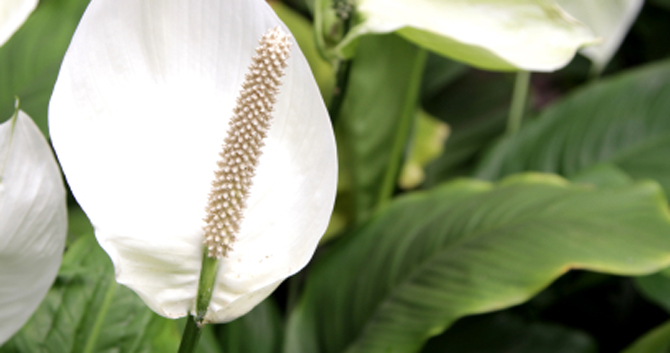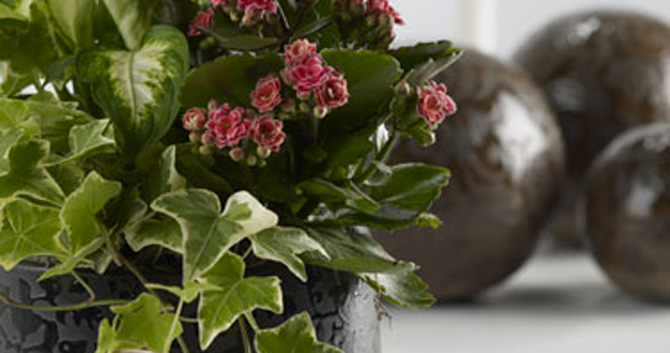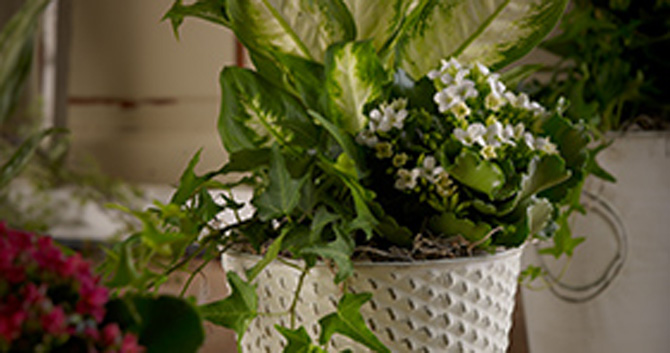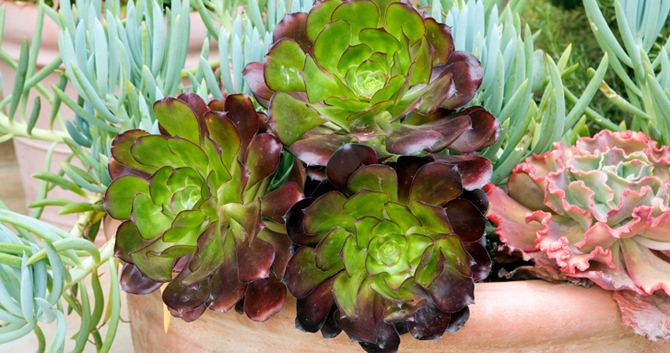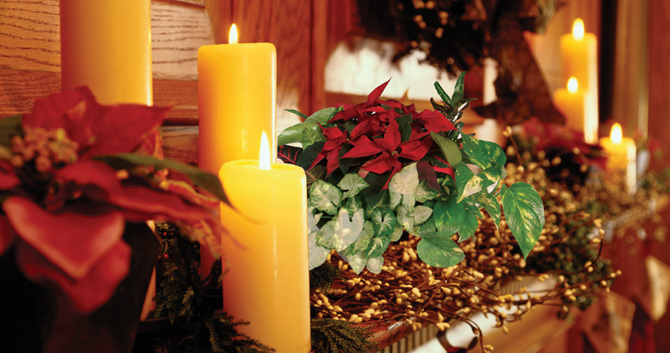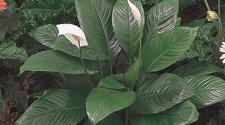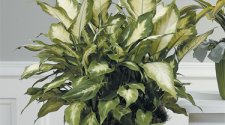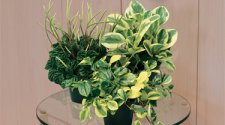Dish gardens are all the rage these days as a way to add a unique natural accent indoors or out. These miniature gardens combine groups of plants in a decorative container to create fashionable home decor that dresses up a living space with interesting textures, unique shapes, and organic color.
 Some of the most popular plants for your succulent dish garden are kalanchoe, aloe, cactus, and jade.
Some of the most popular plants for your succulent dish garden are kalanchoe, aloe, cactus, and jade.
Dish gardens fit just about anywhere - from the kitchen counter to the mantle and even the bathroom vanity. They’re a great way to bring nature indoors, brighten a room, and naturally clean indoor air! With the right plants, dish gardens are maintenance–free, thriving under any condition. They help create a healthy home by removing toxins and create a calming influence that helps reduce stress.
History:
While the origins of dish gardens are obscure, they are said to have begun centuries ago as a Japanese artistic hobby as well as a model for landscape architects. The leading landscape gardeners of Japan would create miniature models of their work to help customers visualize the end result. Three stones were always placed in these Japanese gardens to symbolize Heaven, Earth and Mankind. Americans became fascinated by these tiny landscapes when travelers would bring them home from Japan or make them upon their return.
Emotional benefits:
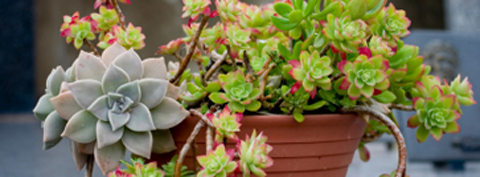 These hardy plants can thrive for long periods in poor conditions.
These hardy plants can thrive for long periods in poor conditions.
Not only can plants fill a home with a burst of color and give caretakers something to nourish, dish gardens also evoke a spirit of peacefulness and serenity. The mere presence of plants in our surroundings brings a feeling of refreshment. They can even lift productivity in the workplace so be wary if the boss gives you a dish garden!
Health benefits:
Houseplants such as dish gardens can filter out toxins in the environment leaving your home full of fresh oxygen to promote peace and relaxation. Dish gardens can also aid in eliminating airborne pollutants and adding humidity to the air making it healthier for us to breathe. Studies have proved that people in indoor environments that contain healthy houseplants exhibit less stress and lower blood pressure. With your new dish garden in place, you may be finding yourself breathing a bit easier- no carbon dioxide needed!
Between dish gardens appearance and livability to their emotional and health benefits, you cannot go wrong with one of these succulents!
Instructions:
You may purchase a ready-made garden designed by a professional florist, or place a special order to get just what you want. They also make a great hands-on project for both kids and adults! Take inspiration from a favorite vacation spot, hobby, or decorating magazine and incorporate it into your very own dish garden. Include accents like stones, miniature figurines, and other features that reflect the theme – from fairy villages, to Zen gardens, to tropical forests. Anything goes.
Looking for a great housewarming present for a new home or apartment? You can’t go wrong with this versatile long lasting gift that brings the outdoors in a lush green instant garden. The plants can always be moved to the garden when it’s time to change the décor.
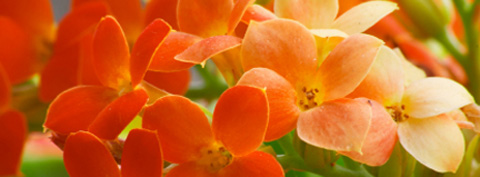 Dish gardens are perfect for adding a burst of color!
Dish gardens are perfect for adding a burst of color!
The key to the perfect dish garden is coming up with the right ingredients for an eye-catching display. Most of the time will be spent on choosing the perfect container, plants and accents because the actual construction of a dish garden is quite simple and quick. Dish gardens can be simple or elaborate.
Container: Finding a container is as much fun as the planting! Look for a shallow, open container with an interesting shape, appealing colors, and unique appeal that suites your personal style. Neutral colors are a great choice for any décor, adding a subtle accent. Looking for a focal point? Try brightly colored containers that add sizzle to their surroundings. The container can be any size, depending on how many or few plants you want to include.
Plants: When planning a dish garden, it’s important to select plants that share similar growing needs in terms of light and water requirements. Since they will all be living together in one container, this will ensure all the plants will thrive.
 Whatever plants you choose, succulents can add a whole new dimension to your collection of unusual and distinctive houseplants.
Whatever plants you choose, succulents can add a whole new dimension to your collection of unusual and distinctive houseplants.
Landscaping the dish garden can be done in a multitude of different ways depending upon the look you are going for. Create different levels of terrain by combining tall, medium, and low growing plants and add contrast by varying the size, texture, and color of the leaves, adding flowering plants for unexpected color. When selecting plants, arrange them at the garden center in the dish you plan to use to be sure you purchase the right number of plants and that they blend well together.
Looking for a desert theme? Succulents, cactus, and other desert plants combine beautifully to create contrasting shades and textures. There is a world of fascinating plants to choose from - combine low growing plants like the spikes of haworthia, the rosettes of hens and chicks (echeveria) or crassula, the smooth green surface of living stone (lithops), and the petite leaves of graptopetalum with taller plants like the brightly flowered kalanchoe, and tall stalks of aloe.
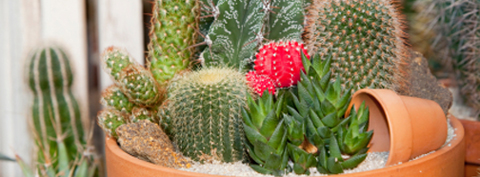 From very small pots that hold only one little cactus to large circular or rectangular bowls and pots dish gardens combine a diverse assortment of succulents.
From very small pots that hold only one little cactus to large circular or rectangular bowls and pots dish gardens combine a diverse assortment of succulents.
For a tropical theme, look for plants with lush leaves and graceful silhouettes. Start with tall colorful bromeliads, soften the edges with the feathery leaves of podocarpus or ptseris fern, and add drama with the dark green glossy leaves of pittosporum, the variegated leaves of croton or dracaena. Fill in with shorter plants like peperomia and complete the look with low spreading plants like creeping fig, and perperomia.
After the plants are arranged, make sure to water your dish garden to set the soil in place.
Soil: Match the soil type to the plants – sandy soils for cactus and succulents, potting mix for houseplants.
Drainage: The most important requirement for success is adequate drainage. Look for container with drainage holes to keep the soil moist but not constantly wet. Place a layer at least one inch in depth of sand, gravel or broken pottery in the bottom of the container.
Types of Plants:
Kalanchoes are a great flowering succulent that adds compact color and fullness to the dish garden. Their delicate clusters of pink, orange, red, or white flowers bloom throughout the winter months to brighten any room. They’re one of the simplest indoor plants to grow, requiring little care. Like most succulents, they need to be planted near a sunny window and don’t need a lot of water.
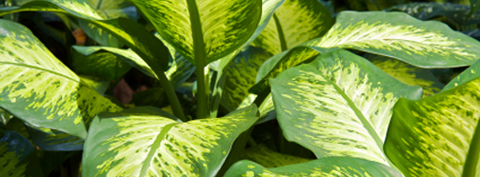 Deffenbachia is one of the simplest indoor plants to grow, requiring little care.
Deffenbachia is one of the simplest indoor plants to grow, requiring little care.
Pothos have long growing leafy vines that help purify indoor air. Its leaves are a pointed heart shape and can vary between greens, whites and yellows. This plant does great in indoor environments, as it likes shade making it great for home and office use. Any one can keep this alive and thriving, even those with “black thumbs”!
Dieffenbachia Another great indoor plant is dieffenbachia – it’s green and white variegated foliage add contrast in the dish garden for year-long interest.
Adding a vibrant blooming Poinsettia to your favorite foliage plants is the perfect addition to any dish garden! Mini-Poinsettias are easy to care for and will live several months or indefinitely provided a good environment. While poinsettias alone will offer for a stunning display, they are even more ideal as centerpieces for dish gardens- creating a focal point for your guests with their vivacious color.
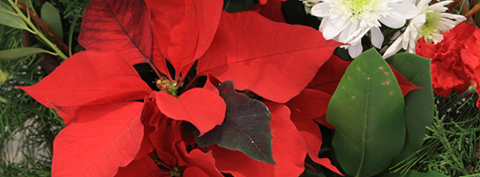 Scarlet and emerald poinsettia make for the perfect Thanksgiving and Christmas hostess gift!
Scarlet and emerald poinsettia make for the perfect Thanksgiving and Christmas hostess gift!
Spathiphyllum also known as the peace lily, is a striking plant when used as a focal point in a dish garden. They bloom in the spring, with long lasting flowers that hover gracefully on over the leaves of thin stalks. Spathiphyllum require little water and sun making it the perfect houseplant producing long lasting beautiful blooms.



